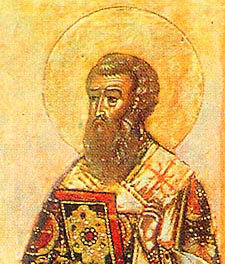Saint Serapion, Archbishop of Novgorod

Saint Serapion was born in the village of Pekhorka near Moscow, and from an early age he was inclined toward monasticism. According to the wish of his parents, he entered into marriage, and was ordained to the priesthood. A year later he became a widower and was tonsured at the Dubensk Monastery of the Dormition. Because of his virtuous life he was chosen as the Igoumen of the monastery and he labored so much for it that it later became known by his name - Serapion's Hermitage.
Wishing to engage in more rigorous ascetical struggles, the Saint resigned his position and entered Trinity-Sergius Lavra, where he became the Igoumen in 1495. The Saint enjoyed the respect of the Great Prince Ivan Vasilyevich, and at his request, the Prince pardoned three convicted boyars who had been condemned to death.
While attending the Council of 1504, Saint Serapion passionately defended the practice of the Church and Monasteries to own property, as a means of charity. This brought him into conflict with Saint Joseph of Volokolamsk (September 9), who taught that the Church should not own villages and estates.
In 1506 he was consecrated as Archbishop of Novgorod. During a great fire in that city in 1508, the Saint tearfully entreated the Lord to extinguish it.
Saint Serapion had to endure many troubles. In 1509 he was deprived of his See and exiled to Moscow’s Andronikov Monastery. In 1511 Saint Serapion moved to Holy Trinity-Sergius Lavra, where he spent the remainder of his life in unceasing meditation and prayer, and was honored by the Lord with the gifts of discernment and of working miracles.
After being tonsured into the Schema, the Hierarch reposed in peace on March 16, 1516. His incorrupt relics were found on April 7,1517, and to this day they rest hidden in Serapion’s Pavilion, at Holy Trinity Cathedral, at the Trinity-Saint Sergius Lavra.
The Lord has glorified His Saint with the gift of miracles, both during his lifetime and after his repose. Once, on the Feast of the Dormition, he healed a lame man, who for many years had crawled on his hands and feet, leaning on pieces of wood.
In 1608, during the siege of the Lavra by the Poles, many monks and laymen, who came to the temple to pray for his monastery, saw him in the vestments of a Hierarch.
